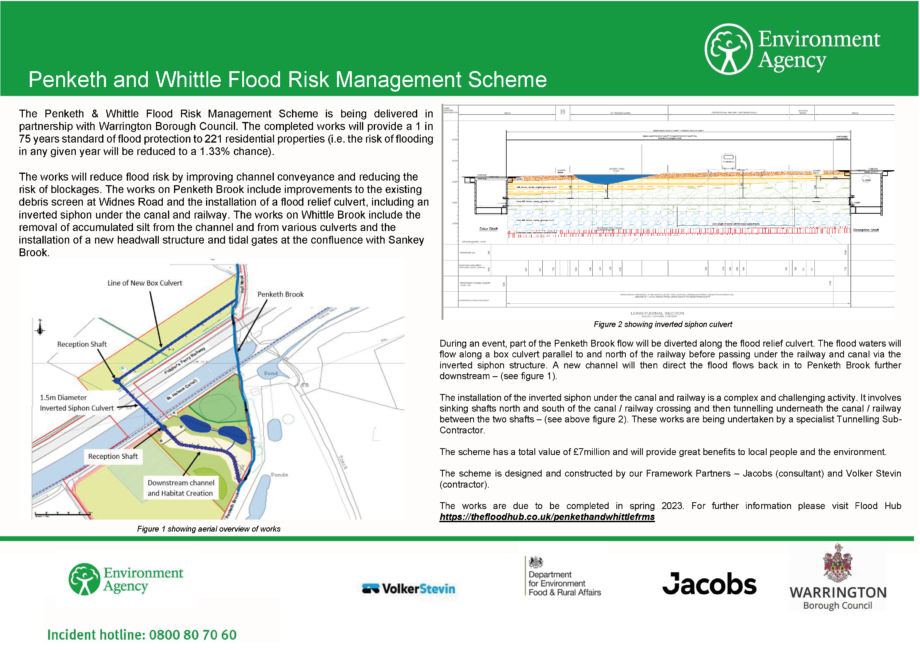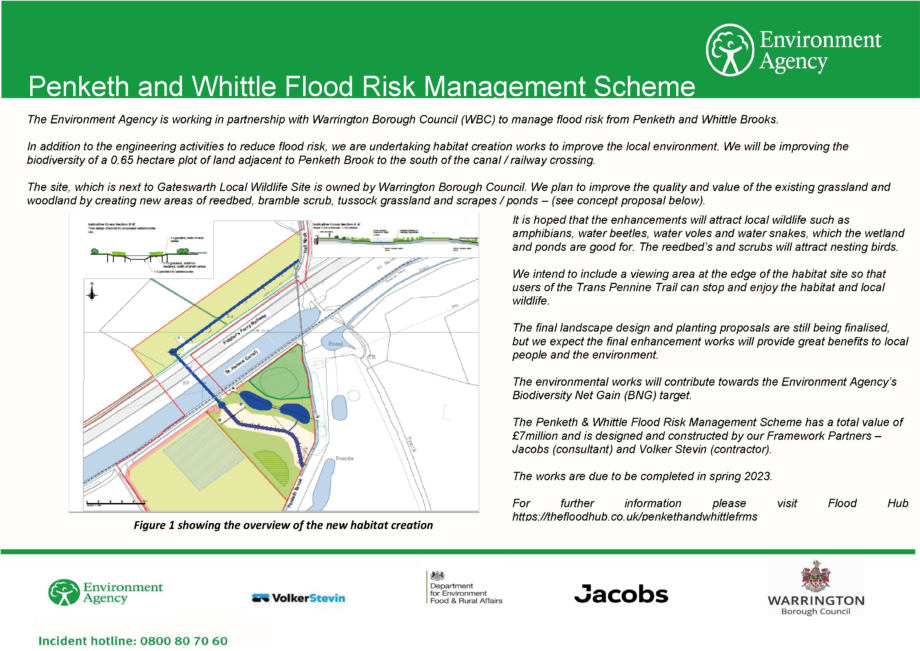Information on this page has been provided by the Environment Agency and was correct at the time of upload. The Flood Hub is not responsible for any information held on this page. For any enquiries, see the Contact section of the page.
Since the Outline Business Case was approved and further investigation has been undertaken, the Environment Agency now propose to provide an overflow culvert on Penketh Brook to enable more water to flow underneath the railway and canal during times of peak flow. This proposal has the benefit of no longer requiring the transfer culvert between Penketh and Whittle Brook or the need for the defences proposed along Hall Nook. This solution will also remove the need for the loss of any existing trees or vegetation along Hall Nook which was a significant concern for some residents.
The revised option will have a lower carbon footprint; reduced construction cost; along with reduced impact to the local residents and environment. The scheme will still reduce flood risk to less than a 1 in 75 annual chance of flooding.
The overflow culvert is proposed to run from Penketh Brook parallel to the railway in a westerly for approximately 140 m before passing underneath it and then returning to Penketh Brook in an open water course.
It is still proposed that tidal gates are provided on Whittle Brook as previously described along with some regrading work to the channel and removal of silt from the culvert on Whittle Brook. Improvements are still also proposed to be undertaken to the trash screen where Penketh Brook passes underneath Widnes Road.
It is proposed that the main works to construct the new culvert on Penketh Brook is undertaken from the fields south of the canal. As such the visibility and impact of the works on the local community will be significantly less than originally anticipated.
The measures to be introduced will be developed to have the minimum carbon emissions achievable to adequately reduce flood risk.
| Milestone | Date |
| Preliminary works start including Site Investigation and Establishment of Site Compound Area | September 2021 |
| Main construction works start on Penketh Brook Culvert | June 2022 |
| Tunnelling works under the Fiddlers Ferry Railway and Sankey Canal | September 2022 |
| Whittle Brook Outfall Construction | Autumn 2022 |
| Construction Completion, Reinstatement and Environmental Works Complete | April 2023 |
Following a site shutdown over the Winter period to allow for the weather to improve for landscaping works, the Penketh and Whittle Project Team are pleased to announce that the Flood Risk Management Scheme is coming to its completion.
221 residential properties are now better protected from flooding from Penketh Brook and Whittle Brook providing a 1 in 75 year standard of protection. The final landscaping and planting is taking place this week to the Biodiversity Net Gain site and field south of the railway line and canal adjacent to Penketh Brook this should be completed by the middle of July. Now the civil engineering works are completed, the site has been reinstated and footpaths have been reopened to the public. In addition to the existing footpaths around the site, a brand-new viewing platform has been created to allow the public to view the Biodiversity Net Gain site from the Trans-Pennine Trail.
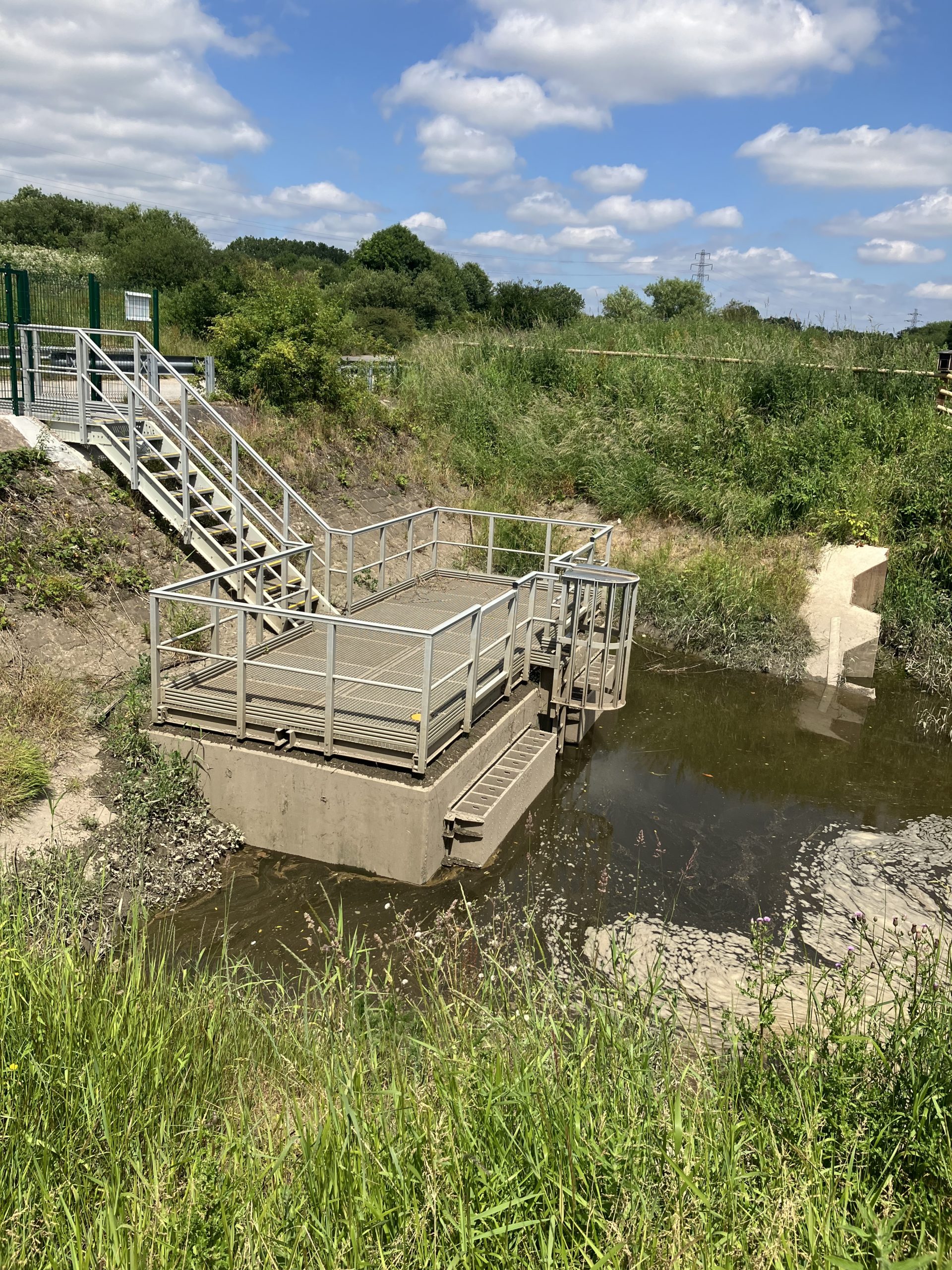
Whittle Brook new Tidal Gates operating to prevent the tidal river flows from entering the culverts under the road. This prevents silt building up within the culverts and blocking them.
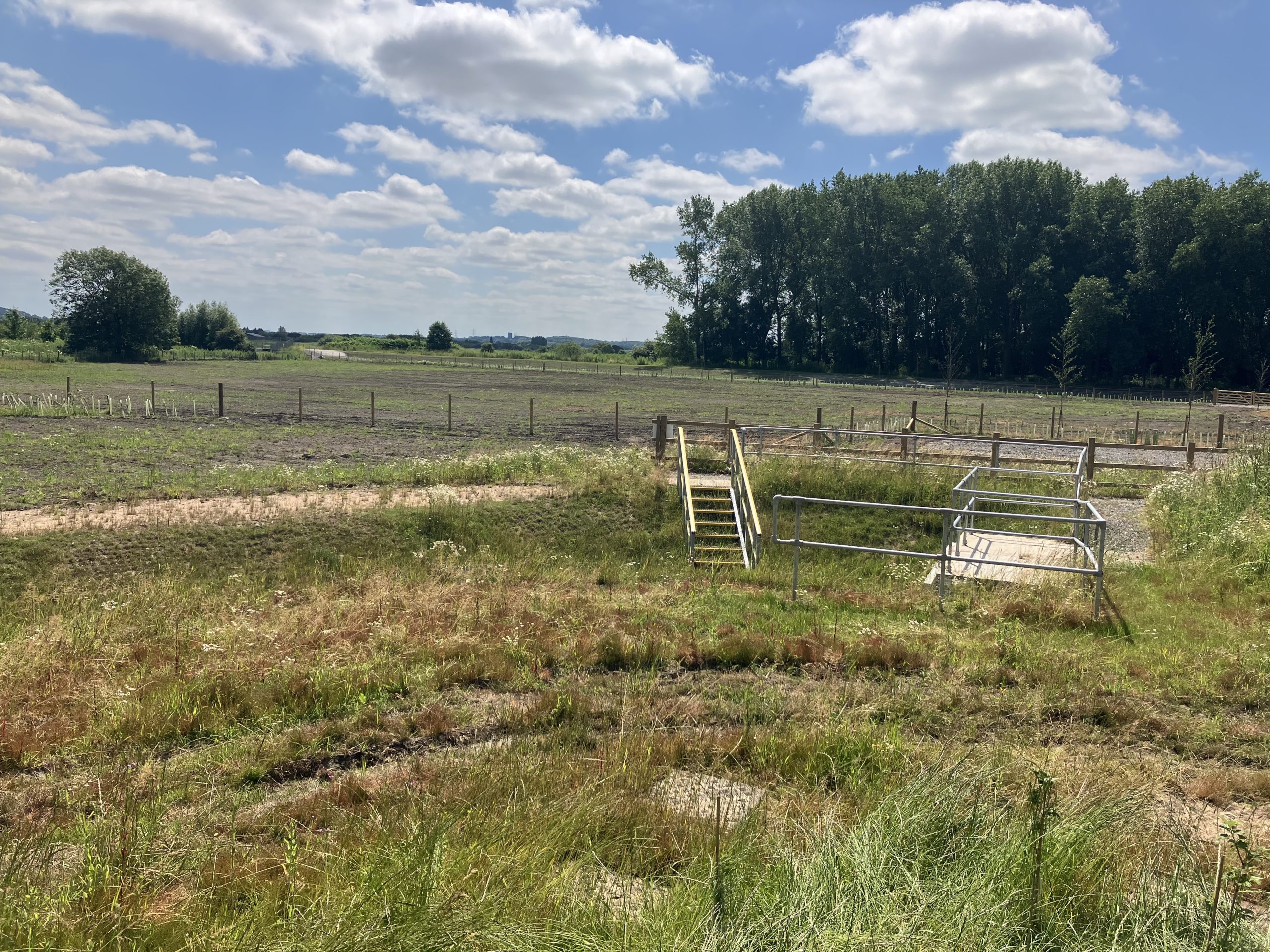
View from the new viewing platform on the Trans-Pennine Trail across the south field and Biodiversity Net Gain habitat site. The main field will be retained in the centre for agricultural use, however hedgerows and wildflower planting will establish around the perimeter of the site.
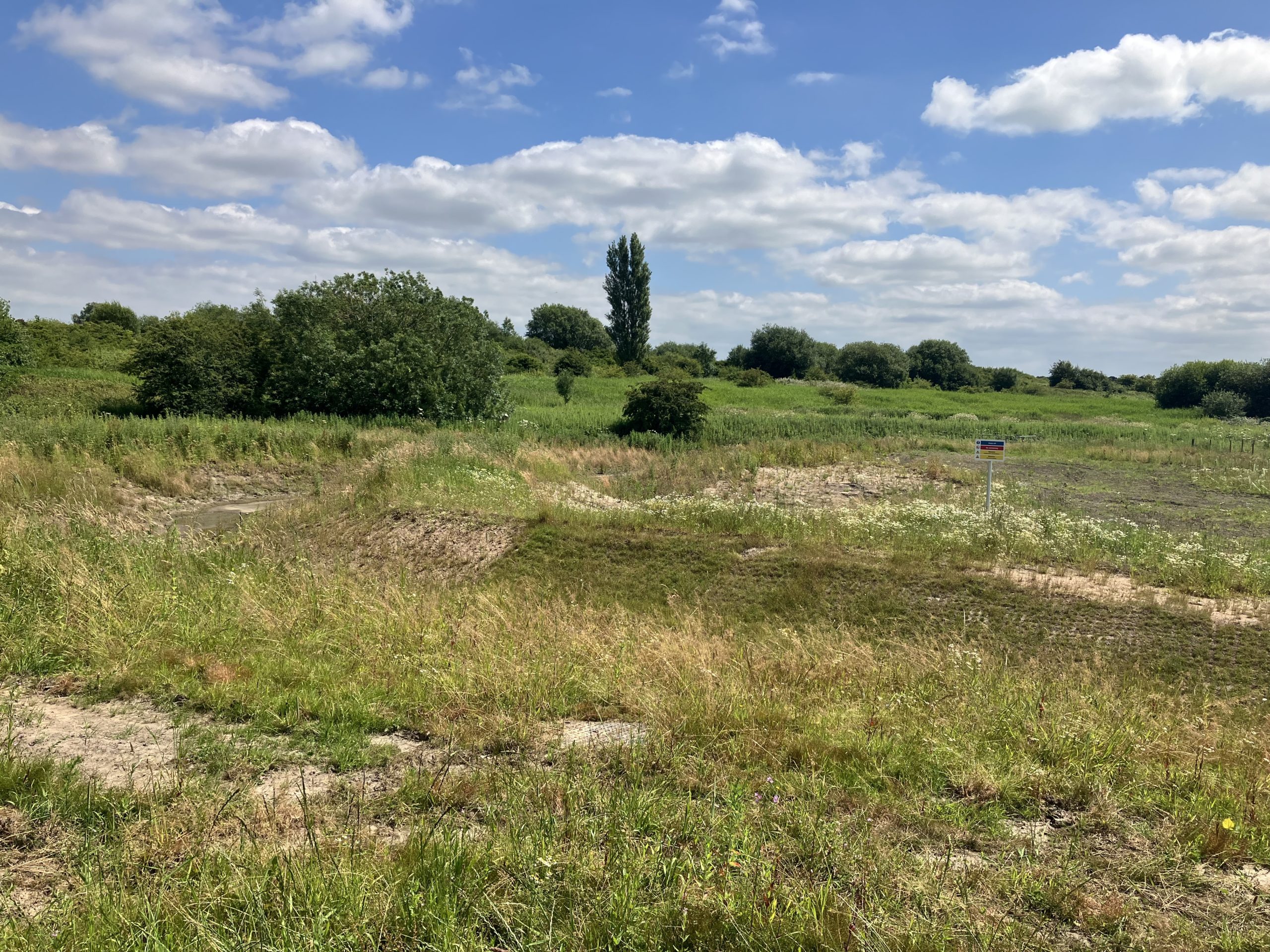
The new Penketh Brook downstream overflow channel which in a flood event will carry river flows from the new tunnel and culvert under the railway and canal back into the original Penketh Brook river channel. There are two ponds to encourage wetland fauna and flora to the habitat site.
Thank you for your patience while the Environment Agency has been undertaking Flood Risk Management work in the area. The engineering works are now complete and operational; however the planting and landscaping works cannot take place until the Spring due to requiring warmer weather for the planting to establish. The Environment Agency will return in the Spring to finish the landscaping works.
During Storm Babet, the river levels in Penketh Brook and Whittle Brook rose substantially which meant the new culvert and tunnel under the canal and railway operated, successfully reducing the potential impact of flooding along Hall Nook. The video below shows the operation of the new overflow culvert.
Penketh Brook New Overflow Culvert Operating during Storm Babet.
At Whittle Brook, the new outfall structure and flood gates is now complete, and a photo of the new structure can be seen above.
The substantial construction works around Penketh Brook are now completed and the works are now in the reinstatement phase. The contractors are currently reinstating the ground level with the soil on site and constructing the future maintenance access track. Once completed the tree planting and grass seeding will take place in the New Year when temperatures increase to allow successful establishment. The photos below show the different areas of the site and progress so far.

Newly constructed public viewing area from the canal towpath, outlet culverts from the bypass tunnel and shaft with security screens and downstream overflow channel
The Whittle Brook Outfall works are now nearing completion with the only outstanding works required being the installation of maintenance access and maintenance platform above the flood doors.
The concrete was poured for the new headwall structure and once this had met the required concrete strength, the flood doors were hung using a crane due to their weight. Once the doors were hung, the over pumping and temporary cofferdam (dry working area) were removed to allow Whittle Brook to flow as normal.
The downstream channel works at Penketh Brook, south of the Canal and Railway were delayed due to a clash with a United Utilities Combined Sewer Outfall. The Environment Agency and their consultants worked with United Utilities to quickly arrange an alternative design which is now currently being constructed. This will allow the remainder of the downstream channel and habitat area to be completed. The Environment Agency expects to be demobilising from site in September which will allow them to reopen up the footpaths which cross the site.
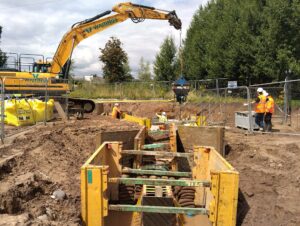
Installation of the diverted surface water outfall pipes. Construction method using trench boxes to hold the excavation open.
The Whittle Brook Outfall works are now awaiting the in-situ concrete pour for the headwall structure. Steel Rebar has been used to create a reinforced frame in which the concrete will be filled around. It will take a day or two for the concrete to set and then the temporary wood panels (known as shutters) will be removed to reveal the new headwall detail.
Works have also begun on the Penketh Brook downstream overflow channel, which once in use will carry floodwater away from the new culvert and tunnel and back into Penketh Brook ready to be discharged into the River Mersey.
There is one further outstanding element of construction still to be undertaken, to provide vehicular future maintenance access through the field gate at the top of the site from Farnworth Road.
For more information, please click here to download a letter from the Environment Agency.
March and April were wet months on the Penketh and Whittle construction site. Due to the Spring tides, the works area at Whittle Brook has been inundated with water on three occasions. Works were temporarily paused so the flood water could be pumped away and then construction recommenced.
The construction works have since been benefitting from better weather and lower tides and are progressing at speed. The headwall structure for the new tidal gates has now had some of the concrete pours required with further to go and the eel tiles have been installed within the two culverts.
Whittle Brook Outfall works are progressing well despite the high Spring tides. The culverts under the road are now completely clear in readiness for the new headwall structure to be built. Below are some updated pictures showing the area.
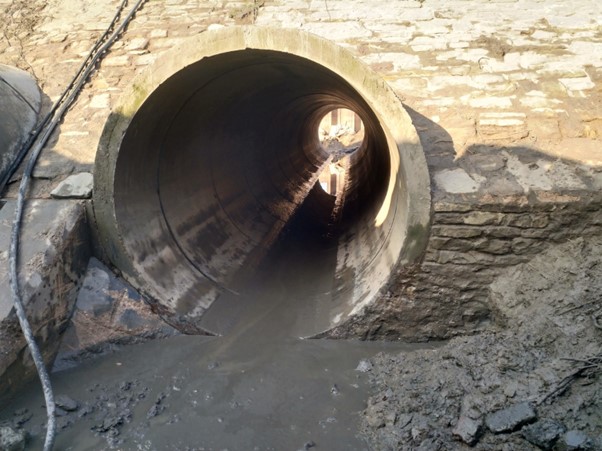
Photo showing the new culverts under the road
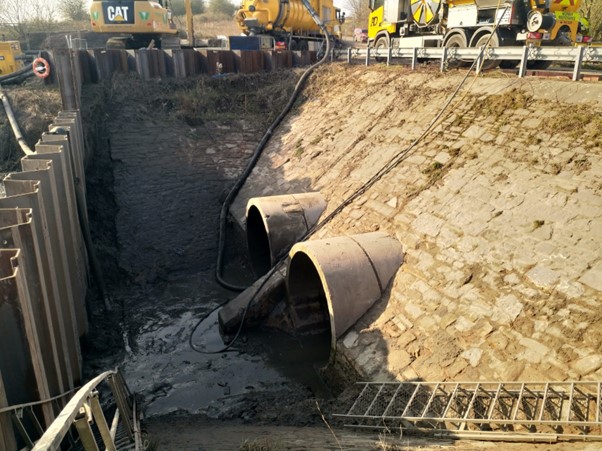
Photo showing the new culverts under the road
The downstream sheet piling has now started to be installed at Whittle Brook, approximately halfway across the channel. Sheet piles are sheets of material designed so that multiple can be fitted together to form a structurally sound wall or barrier. The sheet piles at Whittle Brook are temporary works that are being installed to allow construction of a new headwall and tidal flap valves. The new structure will prevent access of the tide and reduce siltation within Whittle Brook.
Works at Whittle Brook Outfall have now begun, starting with the installation of a piling platform to create a working platform for the crawler crane. The crane will work alongside a couple of excavators to install temporary piles into the channel to create a safe and dry working area. During this time, there will be temporary over pumping of Whittle Brook from the upstream side of the culverts to the downstream side of the outfall.
Happy New Year! The project team hope you had a wonderful festive period, however you choose to celebrate! Works have started again on site and 2023 marks a big year on the project, with a forecasted completion of June.
The project team look forward to providing you all with more updates throughout 2023.
Works on the Penketh Brook culvert and tunnel are nearing completion. Reinstatement of the works area will be undertaken in the Spring of next year to ensure grass establishes in the optimum growing period. Works have begun on Whittle Brook tidal outfall with the construction of the piling platform required for the main works to begin in the new year.
The image below shows the new shaft with the completed tunnel at the bottom. The temporary works are in place for casting concrete to ensure the flood flows are diverted down the new tunnel. November was a particularly wet time on site with the river level being high, which caused flooding the works area. The second photo below shows the new intake to the flood overflow culvert and overspill weir.
Welcome to the Environment Agency Weekly Updates for the Penketh and Whittle Flood Risk Management Scheme. Here you will find construction updates and photos of the progress on site at the 3 work areas – Penketh Brook at Hall Nook, Whittle Brook Outfall to the River Mersey and Widnes Road Trash Screen works.
Tunnelling works under Sankey Canal and Fiddlers Ferry Railway Line have now begun. Traditionally tunnelling boring machines are given girls names, so the machine on this project has been named Emma after the Senior Engineer on site. The rams from the tunnel boring machine push her 0.5m at a time and based on current progress, drilling is due to be completed by Friday 21st October.

Emma the tunnel boring machine beginning to drill from the drive shaft
At Widnes Road, the metal work for the trash screen has arrived on site and been installed by the contractor. The final steps at this location are to install fencing to prevent public access to the screen for safety reasons and also reinstatement and landscaping works to tidy up the site.
Works to install the box culvert at Penketh Brook are continuing currently ahead of programme.
The Environment Agency’s contractor has now begun to construct the drive shaft on the south side of the Sankey Canal and Fiddlers Ferry Railway line. This is a concrete lined shaft which the tunnelling machine will utilise to drill the new tunnel under the canal and railway. A second shaft, known as a reception shaft will be constructed on the north side which will be the exit point for the tunnelling machine on completion. The tunnelling is due to begin in mid-September.
The Environment Agency would like to express their thanks to the local community for their ongoing patience and understanding while these vital works are taking place.
During July, works have begun at Penketh Brook overflow culvert at Hall Nook. Here the Environment Agency and their Contractor will be working to install 57 box culvert sections each measuring 1.5m by 1.2m. The box culvert sections will link Penketh Brook to a new 60m long tunnel under the Fiddlers Ferry Railway and Sankey Canal also to be constructed by the Environment Agency. Together the culvert and tunnel will increase the capacity for flood waters from Penketh Brook to pass under the railway and canal. The contractor is aiming to install the culvert units at a rate of 2 a day with anticipated completion of this element in early August.
The Mersey Valley Sludge Main operated by United Utilities (UU) runs close to the construction works and is a critical asset. As such it was important for the site team and UU to be confident that the asset would not be adversely affected as part of the flood risk management scheme. The site team undertook some ground investigation works to locate the Sludge Main, during the investigations, the Sludge Main was temporarily shut down by UU.
At Widnes Road Trash Screen, the concrete headwall and base structure have been poured and the site team are now waiting for the metal work for the trash screen to be delivered to site for installation in front of the culvert.
